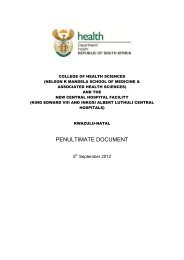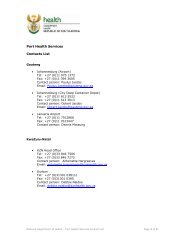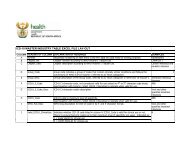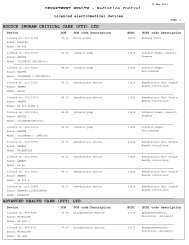National Norms and Standards relating to Environmental Health
National Norms and Standards relating to Environmental Health
National Norms and Standards relating to Environmental Health
You also want an ePaper? Increase the reach of your titles
YUMPU automatically turns print PDFs into web optimized ePapers that Google loves.
• Waste oxidizing substances <strong>and</strong> organic peroxides are s<strong>to</strong>red in plastic lined metal drums, or highdensity plastics drums, fitted with tamperproof sealable lids; <strong>and</strong> the international hazard label <strong>and</strong>the colour coding is per table 1;• Waste <strong>to</strong>xic substances is segregated <strong>and</strong> each type of waste is s<strong>to</strong>red separately;• Waste <strong>to</strong>xic substances are s<strong>to</strong>red in a metal or high density plastic container or drum, which can besealed with a screw cap lid;• Empty containers in which extremely <strong>to</strong>xic chemicals are supplied are not be s<strong>to</strong>red for future use aswaste s<strong>to</strong>rage containers; <strong>and</strong>• Liquid pharmaceutical waste containers are made of metal , or high density plastics , fitted withtamperproof lid or screw cap lid.• Solid pharmaceutical waste is s<strong>to</strong>red in double layer plastic bags, secured by means of non PVCplastics ties, steel wire, non PVC plastic sealing tags of the self locking type or heat sealers that arepurposely made for health care risk waste; <strong>and</strong> the label is per the international hazard colour codingas per table 1;• Cy<strong>to</strong><strong>to</strong>xic <strong>and</strong> geno<strong>to</strong><strong>to</strong>xic pharmaceuticals contaminated are segregated <strong>and</strong> s<strong>to</strong>red in sharpscontainer; <strong>and</strong>• Cy<strong>to</strong><strong>to</strong>xic <strong>and</strong> geno<strong>to</strong><strong>to</strong>xic pharmaceuticals waste <strong>and</strong> contaminated materials is s<strong>to</strong>red in containersmade of metal, or high density plastics, fitted with tamperproof lid or screw cap lid.2.13 LOADING, STORAGE AND TRANSPORTATION AND DISPOSAL OF HCRWAn EHP should also moni<strong>to</strong>r that the loading, s<strong>to</strong>rage <strong>and</strong> transportation <strong>and</strong> disposal of HCRW, <strong>to</strong>ensure that the following requirements are met:2.13.1 Internal loading <strong>and</strong> transportation of health care risk waste in a facilitya) <strong>Health</strong> care risk waste must be transported as follows within a facility:• On wheeled trolleys, containers or carts, with sufficient s<strong>to</strong>rage space <strong>and</strong> designed <strong>to</strong> avoidspillages;• Waste at all major genera<strong>to</strong>rs must be collected <strong>and</strong> removed from the wards <strong>and</strong> departments on adaily basis <strong>and</strong> be s<strong>to</strong>red in locked central s<strong>to</strong>rage area;• The manual lifting of <strong>and</strong> carrying of waste should be avoided <strong>and</strong> minimized;• Access <strong>to</strong> transportation vehicles must be easy, safe <strong>and</strong> unobstructed;• Containers must tightly close <strong>and</strong> secured when loaded;• No waste container must be left unattended during loading <strong>and</strong> transportation;• The container, or trolley or cart wheels must always be locked when not in motion;• The equipment used for transportation must be: Easy <strong>to</strong> load <strong>and</strong> unload; Free from sharp edges that could damage containers during loading or unloading; Easy <strong>to</strong> clean <strong>and</strong> disinfect;• The mode of transport <strong>to</strong> treatment <strong>and</strong> final disposal site must be labeled with appropriate pic<strong>to</strong>gramas prescribed in relevant SANS;• The following information must be recorded for offsite collection of HCRW; Signatures of both the person in charge of the central s<strong>to</strong>rage facility <strong>and</strong> the waste managemen<strong>to</strong>fficer or waste management team member responsible for effective management of waste; Time <strong>and</strong> date of collection; The volume of waste collected for different categories of waste.2.13.2 S<strong>to</strong>rage of health care risk wastea) In terms of the SANS Code 10248, all health care facilities or health establishments must have atemporary waste s<strong>to</strong>rage area, the location thereof must be such that there is minimal risk ofcontamination <strong>to</strong> main operations of that area, medicines, foodstuffs, textiles, employees, patients<strong>and</strong> visi<strong>to</strong>rs.b) Minor genera<strong>to</strong>rs, such as clinics can use the sluice room as a temporary waste s<strong>to</strong>rage area.c) All HCRW s<strong>to</strong>red at minor genera<strong>to</strong>rs must be removed <strong>to</strong> the final s<strong>to</strong>rage area regularly <strong>to</strong> preventthe occurrence of any nuisances.DOH. <strong>Norms</strong> <strong>and</strong> st<strong>and</strong>ards for environmental health in South Africa Feb 2013 129


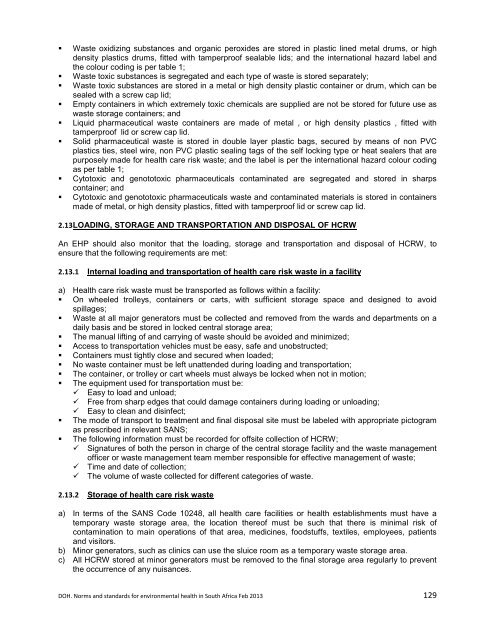


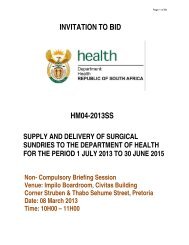
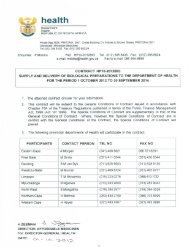
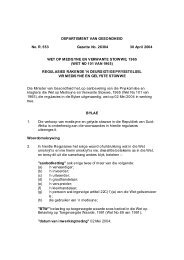
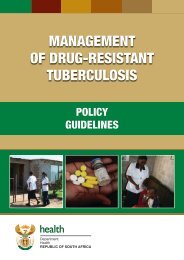
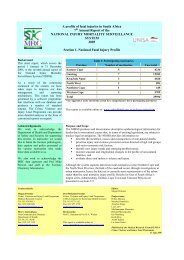
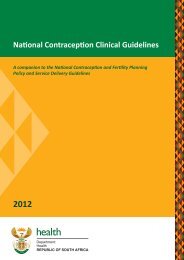
![A monograph of the management of postpartum haemorrhage [2011]](https://img.yumpu.com/15578784/1/184x260/a-monograph-of-the-management-of-postpartum-haemorrhage-2011.jpg?quality=85)
